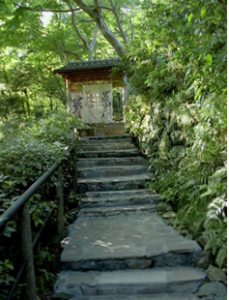Yasunari Kawabata’s birthday month: June <4>

Arashiyama Yusaitei, author of “YamanoOto:The Sound of the Mountain”
Yoshie Doi
We would like to introduce the contents of the lecture given by Professor Kaori Kawabata at the opening lecture of the Kyo-Suzume School’s “Kyoto Love Story” entitled “Kyoto, the city that Yasunari Kawabata loved.” It is a long article, but it is something I would like to remember.
”Kawabata Yasunari’s Kyoto-themed novel, “The Ancient Capital,” was serialized in the Asahi Shimbun newspaper from 1961 to 1962. At the time, Yasunari was writing several novels simultaneously. These included “Senbaduru:A Thousand Cranes” and “Yamanooto:The Sound of the Mountains,” as well as “The Ancient Capital” and “Beauty and Sorrow.” One has to say it was a work of astonishing writing skill.
I will now talk about Yasunari’s postwar literary activities. First, his activities with the Japan Pen Club. Japan lost the war, but there was only criticism of Japan, and no one appreciated its good qualities. Therefore, Yasunari wanted to contribute to peace through literature, and he was very active in this field.
Yasunari was also an avid collector of art. In the postwar period when there was scarcity, he bought up art belonging to old, fallen families and created the Kawabata Collection. This left him in a great deal of debt, and he was constantly in debt for the rest of his life. However, it seems that he was able to use this debt as fuel for his writing.また、
”The Ancient Capital” is a work that Yasunari completed while living in a rented house in Shimogamo. This work was not well received in Japan. Yasunari himself called it a “spoiled novel,” but it was actually this work that earned him the Nobel Prize. The first language this work was translated into was German, and since people in Northern Europe understand German, it was easy for people in Sweden to understand. Moreover, at the time, there was a genre of novels with cities as the main characters, known as city novels, and this was considered modern.
In other words, “The Ancient Capital” was praised as a beautiful, modern urban novel. Furthermore, it also raised questions about the cultural value of how Japanese people themselves value the ancient capital of Kyoto. “The Ancient Capital” expresses a world of fantasy that contrasts with the world of realism, and also contains many allegories and metaphors. This earned it high praise abroad, which is thought to have led to the Nobel Prize.
The beautiful twin girls depicted in the work “The Ancient Capital” are flower spirits, and the violets blooming in a corner of the trunk of an old cherry tree and the bell crickets in a vase were also interpreted as meaningful allegories. At the same time, the work vividly captures the changing seasons of the ancient capital of Kyoto, and is also a seasonal calendar for Kyoto.
Next, we will look at the relationship between Yasunari and painter Kaii Higashiyama. The two men interacted for 17 years, from 1955 until Yasunari’s death in 1962. Kaii first asked to see Yasunari’s art collection, and from then on the two artists began to have frequent exchanges. When Yasunari was awarded the Order of Culture in 1962, Kaii presented Yasunari with a copy of his work, “Winter Flowers,” which is now the cover of the paperback edition of “The Ancient Capital.
Furthermore, when he received the Nobel Prize, he was presented with “First Snow at Kitayama.” The two exchanged around 100 letters, and exhibitions are held all over the country. In one letter, Yasunari asked Kaii to write about Kyoto while he could, as the city’s appearance may soon disappear, and this culminated in Higashiyama’s “Four Seasons of Kyoto.” The Kawabata Yasunari Memorial Association, of which I serve as chairman, was established with the desire to convey to future generations Yasunari’s efforts and contributions to protecting Japanese beauty, and we hold exhibitions of artworks and letters all over the country.
Lastly, the famous painter Yasuda Utsubohiko was also an art collector, and a collector of Ryokan’s works, and exchanged information with Yasunari. In his Nobel Prize acceptance speech, “My Beautiful Japan,” Yasunari quoted Ryokan’s death poem, saying that when people die, they leave nothing behind, but nature remains as it is. How can we preserve and protect this beautiful Japanese nature and hand it down to future generations? I believe that this was Kawabata Yasunari’s challenge.
It was 16 years ago, in 2008, that Professor Kaori spoke at the Kitayama Cedar Museum, but I still remember it vividly. I was so happy, so moved, and so excited to see that he had such a deep understanding of Kyoto and was able to share it with us. It is a happy memory. With the same feelings as Professor Yasunari, I will continue to spread the wonderfulness of Kyoto to the world.
*Arashiyama Yusaitei, where “The Sound of the Mountain” was written. Admission fee: 2000 yen.
Reservations and information for tours – [Official] Arashiyama Yusaitei (yusai.kyoto)
The end of document
Translated by Masami Otani
